What Is a Hernia and How Is it Diagnosed?
What Is a Hernia?
A hernia is when part of the bowels pushes through a weak area in the muscles around the abdomen. This usually happens in the groin, near the belly button, or along a previous surgical scar. The most common type is an inguinal or groin hernia, which is more common in males. Umbilical hernias are also quite common.
Inside the abdomen, there’s a thin membrane called the peritoneum that surrounds the intestines and other organs. If the muscles around the abdomen weaken, this membrane can stretch out through the weak spot toward the skin. This stretching of the membrane is what we call a hernia. Anything inside the membrane, like intestines or fatty tissue, is considered the hernia contents.

Hernia Causes
In younger males, typically under 40 years old, hernias often occur due to an enlargement of the opening where the blood supply to the testicle exits the abdomen. This small opening can vary in size, and if it becomes too large, the bowels may protrude through it. Females can also develop hernias in these areas. Another type of hernia, called a femoral hernia, bulges out through a weak area slightly lower in the groin than where inguinal hernias develop, and it’s more common in females. The repair for these hernias is similar to that for inguinal hernias.
As people age, they may experience weakness in a different area, but the resulting bulge tends to appear in a similar location as other groin hernias. Individuals with a history of abdominal surgery may have incomplete healing of the abdominal wall layers after the initial procedure. Hernias are more likely in these cases, especially if there was any infection in the incision, if the patient is overweight, or if they are taking steroid medication.
How to Diagnose a Hernia
Identifying a hernia typically involves observing a noticeable bulge beneath the skin in the groin, bellybutton, or along an old abdominal incision. However, similar bulges may also be caused by conditions like enlarged lymph nodes, fatty tumors, or other types of tumors. A hernia-related bulge typically diminishes when lying down and enlarges during coughing or straining.
Groin pain without a visible bulge could suggest a hernia, though it might also be attributed to muscle strain or inflammation. A surgeon can assess for a groin hernia by placing a finger just under the skin fold above the scrotum and asking you to cough or strain. Occasionally, an ultrasound may be recommended for a more detailed examination.
Hernias are common, especially in males. While self-diagnosis is often accurate when there’s an obvious bulge, it’s essential to note that other conditions can mimic hernia symptoms. If you experience pain in the area without a clear bulge, the discomfort may stem from a different source, warranting a professional medical evaluation.
